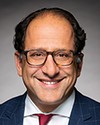Thank you, Mr. Chair.
As my public service career began with my being a parliamentary page—in my case, in the Senate—I always like to begin by commending Parliament for the opportunities that program offers to Canadian students.
Mr. Chair, on September 13, renewed clashes broke out between the armed forces of Armenia and Azerbaijan. Each side blamed the other for the hostilities, and immediate high-level international engagement contributed to a ceasefire that came into effect on the evening of September 14. Since then, the situation has remained tense but stable.
Over 200 people, mainly soldiers, from both sides were reportedly killed in the clashes,135 Armenian personnel and 77 from Azerbaijan. Both sides also reported civilian casualties and several injuries. The recent hostilities were unprecedented in terms of intensity and represented the most serious escalation since the end of the second Nagorno-Karabakh war in 2020.
Border clashes have occurred periodically since the November 2020 ceasefire. However, the recent escalation was different, as there were credible reports of Azerbaijani strikes inside Armenia, well beyond the border.
Azerbaijan justified its shelling as a response to Armenian provocations, including the alleged laying of Armenian-produced land mines in Azerbaijani territory. There has been speculation that Azerbaijan was taking advantage of a distracted Russia and west to push Armenia towards a political settlement on their terms.
As seen with previous border clashes, mutual accusations obscure our visibility. It is difficult to discern clear facts, as there is no international presence in the border areas.
Armenia has publicly voiced concerns that Azerbaijan appeared to be planning another operation and has called for the continued engagement of the international community, including from Canada.
Immediate and high-level reaction of the international community was critical in calming the situation. These efforts included calls for immediate de-escalation and the need to frame a path forward between the two parties.
The leadership of the United States and France undertook direct active engagement with the parties. European Council President Charles Michel and EU High Representative Josep Borrell conducted calls with the leaders of the region, and EU Special Representative for the South Caucasus Toivo Klaar travelled to the capitals of both countries.
At Armenia’s request, the Collective Security Treaty Organization (CSTO) undertook an assessment mission to Armenia, which started last week. In multilateral forums, the Organization for Security and Co-operation in Europe, the OSCE, held a special meeting of the Permanent Council on September 13. The UN Security Council held two meetings on the situation on September 14 and September 15.
The OSCE has for years tried to manage this conflict, but the work of the Minsk Group, co-chaired by France, the United States and Russia, has increasingly been sidelined.
The EU has been playing an increasingly active role that has gained some traction. Under EU mediation, the two Armenian and Azerbaijani leaders agreed to start drafting the bilateral peace agreement and set up a joint commission on demarcating their common border. These efforts have been continuing, with further meetings planned for this fall. It remains to be seen how recent events will impact this process.
Canada immediately reacted to the escalation in hostilities by expressing its deep concerns and by calling for calm through social media, on September 13, urging de-escalation, respect for the ceasefire, and a return to dialogue. Minister Joly spoke to her counterparts from both countries. She held a call with Armenian Minister Ararat Mirzoyan on September 15, and a call with Azerbaijani Minister Jeyhun Bayramov on September 17.
In her conversations, Minister Joly expressed condolences for the loss of life, welcomed the ceasefire, urged further de-escalation and continued respect for the ceasefire, and stressed the importance of meaningful dialogue.
She underlined that the reports of Azerbaijani strikes in Armenian territory were especially worrying—in particular, damage to infrastructure and civilian casualties—reiterating the importance of territorial integrity and the unacceptable use of force. She stressed that there is no military solution to this conflict.
Canada remains ready to support measures to stabilize the situation and to encourage negotiations for a comprehensive peace treaty. We welcome the ongoing engagement of the OSCE, the EU's important work to further dialogue and bilateral engagement by our partners such as the U.S.
We continue to monitor the situation and to engage directly with the parties, encouraging them to continue working together, with international support, to build mutual confidence at this sensitive time.
Canada enjoys positive bilateral relations with both countries. Thousands of Canadians trace their heritage to Azerbaijan and Armenia and serve as important links between our societies.
Canada-Azerbaijan relations are reinforced by our mutual commitment to shared global priorities, including environmental stewardship, and Canada appreciates Azerbaijan's co-operation in Afghanistan and its delivery of humanitarian assistance to Ukraine.
Canada supports Armenia's social and democratic reforms through initiatives such as the mission of Special Envoy Stéphane Dion and the Arnold Chan initiative for democracy and supports the Armenian parliament. We look forward to opening an embassy in Yerevan.
For these reasons, Canada encourages both Armenia and Azerbaijan to engage in meaningful dialogue towards a comprehensive and sustainable peace, which will provide a better future for all citizens.
Thank you, Mr. Chair.




